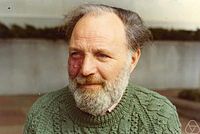Isadore Singer
Isadore Singer | |
|---|---|
 Isadore Singer, 1977 | |
| Born | May 3, 1924 |
| Nationality | American |
| Alma mater | University of Michigan University of Chicago |
| Known for | Atiyah–Singer index theorem |
| Awards | Bôcher Memorial Prize (1969) National Medal of Science (1983) Wigner Medal (1988) Steele Prize (2000) Abel Prize (2004) |
| Scientific career | |
| Fields | Mathematics |
| Institutions | MIT |
| Doctoral advisor | Irving Segal |
| Doctoral students | Richard L. Bishop Dan Freed John Lott Linda Rothschild Frank W. Warner Andrew Browder Hugo Rossi |
Isadore Manuel Singer (born May 3, 1924) is an American mathematician. He is an Institute Professor in the Department of Mathematics at the Massachusetts Institute of Technology. He is noted for his work with Michael Atiyah proving the Atiyah–Singer index theorem in 1962, which paved the way for new interactions between pure mathematics and theoretical physics.[1]
Biography
Singer was born in Detroit, Michigan, and received his undergraduate degree from the University of Michigan in 1944.[2] After obtaining his M.S. and Ph.D. from the University of Chicago in 1948 and 1950 respectively, he taught at UCLA and MIT, where he has spent the majority of his career.[3]
He was chair of the Committee of Science & Public Policy of the United States National Academy of Sciences, a member of the White House Science Council (1982–88), and on the Governing Board of the United States National Research Council (1995–99).[3]
Awards and honors
Singer is a member of the National Academy of Sciences and the American Academy of Arts and Sciences. He is a member of the Norwegian Academy of Science and Letters.[4] In 2012 he became a fellow of the American Mathematical Society.[5]
Among the awards he has received are the Bôcher Memorial Prize (1969) and the Steele Prize for Lifetime Achievement (2000), both from the American Mathematical Society, the Eugene Wigner Medal (1988), the National Medal of Science (1983), the Abel Prize (2004, shared with Michael Atiyah),[6] the 2004 Gauss Lecture and the James Rhyne Killian Faculty Achievement Award from MIT (2005).[7]
Works
- Quantum field theory, supersymmetry, and enumerative geometry. Freed, Daniel S. and Morrison, David R. and Singer, Isadore editors. IAS/Park City Mathematics Series, Vol. 11. American Mathematical Society Providence, RI viii+285. Papers from the Graduate Summer School of the IAS/Park City Mathematics Institute held in Princeton, NJ, 2001. (2006)
See also
References
- ^ Devlin, Keith (April 2004). "Abel Prize Awarded: The Mathematicians' Nobel". Devlin's Angle. Mathematical Association of America.
- ^ http://www-history.mcs.st-and.ac.uk/Biographies/Singer.html
- ^ a b MIT Maths Biography
- ^ "Gruppe 1: Matematiske fag" (in Norwegian). Norwegian Academy of Science and Letters. Archived from the original on 10 November 2013. Retrieved 7 October 2010.
{{cite web}}: Unknown parameter|deadurl=ignored (|url-status=suggested) (help) - ^ List of Fellows of the American Mathematical Society, retrieved 2013-07-20.
- ^ http://www.abelprisen.no/en/prisvinnere/2004/interview_2004_1.html
- ^ http://www.maths.adelaide.edu.au/mathai.varghese/MIT_2006_fall%207.pdf
External links
- "Isadore Singer". MIT Mathematics: People. Massachusetts Institute of Technology.
- O'Connor, John J.; Robertson, Edmund F., "Isadore Singer", MacTutor History of Mathematics Archive, University of St Andrews
- Isadore Singer at the Mathematics Genealogy Project
- 1924 births
- Abel Prize laureates
- American Jews
- 20th-century American mathematicians
- 21st-century American mathematicians
- Living people
- University of Michigan alumni
- Massachusetts Institute of Technology faculty
- Members of the United States National Academy of Sciences
- National Medal of Science laureates
- Members of the Norwegian Academy of Science and Letters
- Fellows of the American Mathematical Society
- Guggenheim Fellows
